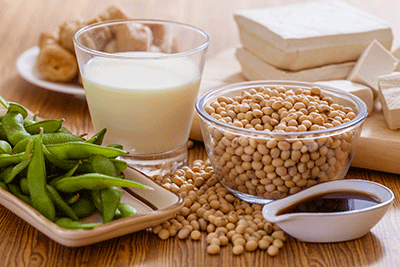Is Soy A Remedy For Menopausal Symptoms?
 Essentially, everyone has heard the term “soy” as in edamame soy beans, soy flour, tempeh, tofu, soy milk, or soy sauce; a multibillion dollar industry. Why so popular? Perhaps, it is because many of our currently available commercial hormone preparations originate from soy. And for women of Asian descent raised on a diet rich in soy, the rates of hot flashes and breast cancer are reduced significantly compared to those of North American women.
Essentially, everyone has heard the term “soy” as in edamame soy beans, soy flour, tempeh, tofu, soy milk, or soy sauce; a multibillion dollar industry. Why so popular? Perhaps, it is because many of our currently available commercial hormone preparations originate from soy. And for women of Asian descent raised on a diet rich in soy, the rates of hot flashes and breast cancer are reduced significantly compared to those of North American women.
The biology of soy is complex and only partially understood. Soy is a plant protein containing phytoestrogens (hormones derived from plants) called isoflavones , which have an estrogen‐like structure that binds weakly to estrogen receptors. Soy isoflavones have been described as either stimulating or blocking estrogen responses. If soy isoflavones attach to estrogen receptors not normally involved in the body’s hormone function, their actions are considered stimulating. If they occupy important receptors that need the body’s own estrogens, they act as a blocking agent.
Soy isoflavones are made up of genistein, daidzedin, and other lesser soy metabolites. Whole soy beans have equal amounts of genistein and daidzedin, while the soybean germ has four times as much daidzedin as genistein. All commercial soy isoflavones are attached to sugar molecules, which may make up as much as 50% of the isoflavone. During consumption, sugar is removed in the intestine, resulting in a metabolically active aglycone (without sugar) isoflavone. The intestinal bacteria then convert most of the aglycone into the isoflavone metabolites equol, a daidzedin metabolite, which can be measured in the urine, and p‐ethylphenol, both of which are then absorbed into the blood stream. Equol, the more important of the two, has two forms, S(‐) equol, believed to be the active form, and R(+) Equol. In one six‐month clinical trial in which women were administered a placebo or soy isoflavones, those that demonstrated equol in their urine reported a significantly reduced number of hot flashes, less excessive sweating, fewer palpitations, and less weakness and limb paresthesias when compared with those who received a placebo or when compared with isoflavone‐treated women who did not produce equol. Unfortunately, only 20% to 30% of Western women produce S(‐) equol, as compared to 50% to 60% of Asian women, which may explain the differences in hot flashes and breast cancer risk between the two populations.
The future direction of soy research is predicated on understanding better how soy interacts with individual estrogen receptors and the inflammatory proteins of menopause. Soy isoflavones are about one third as effective as estrogen in reducing hot flashes. However, prolonged daily soy consumption has been shown to reduce important menopause-related inflammatory proteins.
The role of soy biology is important, and it will be the scientists, working with clinicians, who ultimately define its usefulness in menopause management.
By James Woods, M.D.
Dr. Woods treats patients for menopause at the Hess/Woods Gynecology Practice.
Disclaimer: The information included on this site is for general educational purposes only. It is neither intended nor implied to be a substitute for or form of patient specific medical advice and cannot be used for clinical management of specific patients. Our responses to questions submitted are based solely on information provided by the submitting institution. No information has been obtained from any actual patient, and no physician‐patient relationship is intended or implied by our response. This site is for general information purposes only. Practitioners seeking guidance regarding the management of any actual patient should consult with another practitioner willing and able to provide patient specific advice. Our response should also not be relied upon for legal defense, and does not imply any agreement on our part to act in a legal defense capacity.
James Woods |
3/2/2015
You may also like